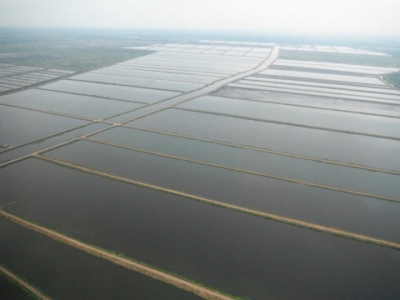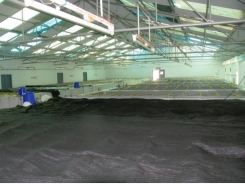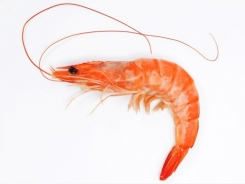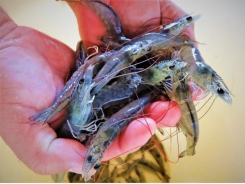Retrofitting shrimp farms to recirculating systems

Technology advantageous to large, open, semi-intensive operations
Effective retrofitting of large, semi-intensive shrimp farms to recirculating operation has several advantages and provides improved and stable water quality. Note consistent water coloration in these production ponds.
For several years, our team has collaborated in the development and fine-tuning of technology to retrofit and “close” semi-intensive shrimp farms with large, open ponds typical of the Latin American region so that they can be operated using a water-recirculation approach. As described below, this approach has been relatively common in many Asia shrimp farming areas but practically non-existent in Latin America until the last decade.

Authors during recent visit to shrimp farm in Central America.
The technology was developed by combining known and established commercial water treatment technologies used worldwide with the technology developed to operate shrimp production units – mostly nurseries – using bacterial bioflocs and zero water exchange for up to 150 days, with excellent production and survival results. It has been successfully applied at major shrimp farming operations throughout Latin America, and we believe the technology can be applied more widely and elsewhere.
The reasons to retrofit a large farm include better management of various shrimp diseases (by excluding pathogens and vectors), and to improve water quality in production ponds in areas that are significantly affected by seasonal weather variations in temperature, rainfall (salinity), microbial community composition and other annually cyclic variables.
More stable conditions and better water salinity control allow for co-production of other species like tilapia in some areas. And by significantly reducing water inputs from the environment, in addition to obvious biosecurity benefits, other issues – red tides, industrial, agriculture or urban pollution and others – can be mostly eliminated.
Shrimp culture systems in Asia
The shrimp farming industry in Asia is typically intensive and involves the use of small ponds 1 hectare or less in size, and with increasing average depths. Many ponds are lined with plastics, and typically have mechanical aeration through paddlewheels and/or blowers pumping air through diffusers on the pond bottoms at around 1 HP per 400 to 600 kilograms of shrimp produced. There is significant use of probiotics. High-density nurseries are used as an intermediate phase between the hatcheries and the grow-out ponds, and ponds are typically stocked at 100 or more animals per square meter.
There has also been a major move in the past few years towards markedly reduced water exchange rates that support biosecurity through the exclusion of disease pathogens and vectors. Many farms have also become “closed” and operate under water recirculation by converting some ponds into reservoirs and implementing maximum water reuse.
Shrimp culture systems in Latin America
In Latin America, a significant majority of the shrimp farms are semi-intensive and operate at medium stocking densities. These facilities are built above the high-tide line and include a pumping station and water distribution canals and reservoirs, mostly using commercial formulated aquafeeds. The ponds are harvested by draining through a net or by using a harvest pump. The farm layout is generally asymmetrical, particularly for older farms that were built to take advantage of every square meter of land, although newer farms tend to be more symmetrical than extensive farms.
Pond preparation may be quite elaborate with dry-outs typically done once annually, tilling and liming with various liming materials, and fertilization with various compounds to promote natural production. Applications of various bacterial inocula to improve water quality is becoming more common. Organic fertilizers (mostly manure and agricultural byproducts) were widely used in the past, but this practice is disappearing for various reasons, including biosecurity concerns.
Pond natural productivity is important for juvenile shrimp growth during the early weeks after stocking. Although the water exchange rates typically used are 5 to 10 percent of pond volume per day, in recent years many farmers have adopted more stringent exchange practices of 2 to 5 percent. These lower exchange rates reduce pumping costs, and minimize fertilizer needs and the possibility of pathogen introduction.
While there are farms in the Americas that have been able to successfully convert from semi-intensive to more intensive production modes, these are relatively rare and there does not appear to be any real move towards the widespread adoption of this technology in the region, even though land availability is generally not a restriction to further industry growth. Production models in the Americas remain largely based on larger ponds (5 to 10 hectares) stocked at 10 to 30 animals per square meter using lab-reared PLs often selected for growth and survival against prevailing pathogens, reduced water exchange rates, use of manufactured aquafeeds and with some mechanical aeration, and increased use of intermediate nurseries in recent years (Jory, D.E. In press. Aquaculture, 3rd edition. Ch. 21 – Marine Shrimp. Wiley).

Aerial view of a retrofitted farm showing a sedimentation unit, production ponds and reservoir.
Steps involved in converting to recirculating operation
Retrofitting a shrimp with many large ponds – originally designed to work with significant flow-through water exchange – to operate recirculating its water requires a number of steps, careful planning and detailed implementation. Typically, these steps first involve a comprehensive topographic assessment, and detailed calculations of water volumes, water residence times and other hydraulic data.
The proper design optimizes sedimentation of suspended solids and water movement/recirculation around the farm, with its inherent benefits (increasing water movement and oxygenation, promoting aerobic degradation of sludge, others), and while some farms are better suited for retrofitting, most farms can be converted to recirculation to at least some significant degree. Water movement/recirculation through the farm homogenizes it, and promotes destratification, degassing and dissolved oxygen levels.
In a recirculating system, water treatment occurs in situ – through movement, aeration and applications of bacterial amendments – and often also requires sacrificing some ponds to build one or more sedimentation units. These sedimentation units must have an area no less than 10 percent of the farm pond area, often are at least twice as deep as the average production ponds, and have a hydraulic retention time of two to three days with a typical recirculation percentage of 10 to 20 percent.
It is very important that any retrofitting design has clear and achievable goals based on realistic expectations. The technology typically does not reduce the total energy costs to operate a farm, but changes how the energy is utilized, with much more emphasis on moving and homogenizing the water around the farm instead of pumping new water into the farms to then release it back to the environment as effluents.



Separate production facilities are needed to produce the large volumes of bacterial amendments applied to the water system on a regular basis.
An important component of the operation of a recirculating farm is regular applications of bacterial amendments (we use our own formula for this purpose) to aid in and support degradation of sludge and organic matter, reduce the incidence of pathogenic microorganisms, and improve overall water quality. Essentially, to convert the entire farm water volume into an autotrophic/heterotrophic floc system. This requires setting up a separate bacterial production facility within the farm, or more than one unit depending on the size and modularity of the farm, and distances involved.


View of applications of bacterial amendments.
Management of large shrimp ponds, once the farm has been retrofitted to operate in a recirculating water mode, requires thorough and timely monitoring of several water quality parameters, with an adequately set up, staffed and supported laboratory. Management of a recirculating farm also requires personnel with a better technical background and an understanding of how the new system works. As continuous water circulation is critical, the operation of aerators and circulators must be assured as is their supply of energy (redundancy is key).
Some recommendations to improve and expedite the stability of a new recirculating system:
- All procedures should be approached and managed in a prophylactic, not a therapeutic manner; the bacterial addition component is critical, and should be incorporated before the beginning of the cycle and before stocking the shrimp PLs.
- Special attention must be given to water quality – in particular dissolved oxygen levels – monitoring during overcast days.
- Excess water from rainfall should be released out of the system.
- Although farm performance will improve over time, ponds should still be dried out occasionally, and this decision will depend on their overall performance and appearance.

Careful monitoring and control of several water quality and microbiological parameters are very important for proper operation of retrofitted farms operated under recirculation.
Advantages and disadvantages to recirculation retro-fitting
The technology has numerous beneficial effects, and the retrofitted farms are very environmentally friendly systems as effluents are essentially eliminated. There is a significant reduction of suspended solids, and biological and chemical oxygen demands due to improved soil quality and bacterial action; also, a marked reduction in undesirable smells and flavors from the exclusion of cyanobacteria and fungi due by competitive exclusion. Pumping efficiency is increased due to the lower pumping levels, idle time between production cycles is reduced and there is no need for organic or inorganic fertilization. Mechanical aeration requirements for the more intensive systems can often be significantly reduced, as the recirculation promotes higher dissolved oxygen levels.
There is increased biosecurity from minimal pumping of new water from outside (exclusion of pathogens and vectors), minimal inputs of pollutants and the resulting environmental stability (dissolved oxygen, salinity, pH, bacterial communities, others) within the system reduces stress levels on the cultured shrimp and their susceptibility to diseases, and supports shrimp survival and growth, better pigmented animals at harvest, and overall productivity.
The retrofitting/recirculation technology also has some important considerations that can limit its application. The initial retrofitting and construction costs are high, and operations require a high technical level of knowledge by dedicated personnel. Dependence on mechanical aeration is very high – up to 24 hours may be required in some cases. There can be some limitations in pumping capacity and options depending on the characteristics of the original ponds and their layout. There are significant inputs required involving bacterial additions, and to maintain water ionic balance during the rainy seasons.

Recirculating the water through a farm under the proper retrofitting model can significantly improve overall water quality.
Perspectives
Retrofitting existing, large shrimp farms – originally built to operate using significant, flow-through water exchange with the surrounding environment – to a recirculating operation mode requires significant infrastructure modifications and a different management scheme. Some farms are better suited for retrofitting, but most farms can be converted to recirculation to at least some degree, and this has been our experience with several companies throughout Latin America. The benefits are numerous, including improved biosecurity (pathogen and vector exclusion), and more stable water quality and desirable microbial community composition. Recirculation through the farm homogenizes the water, and promotes destratification, degassing and dissolved oxygen levels.
Related news
Tools

Phối trộn thức ăn chăn nuôi

Pha dung dịch thủy canh

Định mức cho tôm ăn

Phối trộn phân bón NPK

Xác định tỷ lệ tôm sống

Chuyển đổi đơn vị phân bón

Xác định công suất sục khí

Chuyển đổi đơn vị tôm

Tính diện tích nhà kính

Tính thể tích ao




 Microalgae into medicine: Biotech startup targets shrimp, salmon…
Microalgae into medicine: Biotech startup targets shrimp, salmon…  Krill meal performs well in shrimp feed experiments
Krill meal performs well in shrimp feed experiments